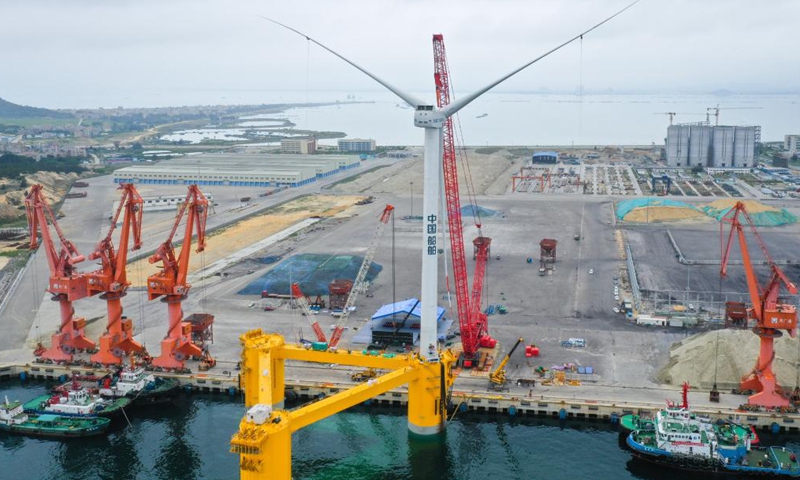
Aerial photo taken on May 27, 2022 shows a deep-sea floating wind power equipment "Fuyao" in Maoming, south China's Guangdong Province.Photo:Xinhua
China will ramp up efforts to develop clean and low-carbon power equipment in 10 fields including thermal power, hydropower, nuclear power and wind power in order to improve the nation’s power equipment supply structure in the next five to eight years, according to a plan revealed by China’s Ministry of Industry and Information Technology and four other administrations.
Experts noted that the plan is aimed at guiding provinces and regions nationwide to transform and improve energy structure to ensure power supply, in a bid to further ensure the target of achieving carbon peaking by 2030.
According to the plan, the country will promote energy-saving and carbon-reducing transformation of coal power equipment. It will also accelerate the development and application of variable-speed and offshore pumped storage equipment as well as the fourth generation of nuclear power equipment.
The country is also eyeing the research and development of new energy generation equipment, promoting integration with wind and photovoltaic energy and accelerating the research and application of equipment for developing ocean energy and geothermal energy.
“The plan will guide localities to carry out specific measures to achieve energy structure transformation, which is in line with the country’s goal of carbon peaking by 2030,” Lin Boqiang, director of the China Center for Energy Economics Research at Xiamen University, told the Global Times on Monday.
According to the plan, in the next five to eight years, the country will significantly improve its power equipment supply structure with high efficiency of grid transmission and distribution. The supply capacity of renewable energy power generation continues to improve, with wind and solar power generation equipment meeting the installed demand of more than 1.2 billion kilowatts, and nuclear power equipment meeting the installed demand of 70 million kilowatts.
The plan requires the central government to guide local industry authorities to release supporting measures, as well as enhancing financial support for eligible power equipment enterprises and strengthening professional training.
Since China proposed its dual carbon targets in 2020, the country has implemented a series of measures to develop renewable energy.
Li Chuangjun, director general of the Department of New Energy and Renewable Energy Sources of the National Energy Administration (NEA), said during a carbon neutrality forum held on Saturday that the construction of wind and photovoltaic power plants in northwestern desert regions will be the priority of China's carbon emissions reduction during the 14th Five-year Plan period 2021-25.
The construction of the first group of renewable power plants with capacity of 100 million kilowatt-hours has begun, said Li, noting that the electricity volume generated by renewable power sources will reach 3.3 trillion kilowatt-hours by 2025.
